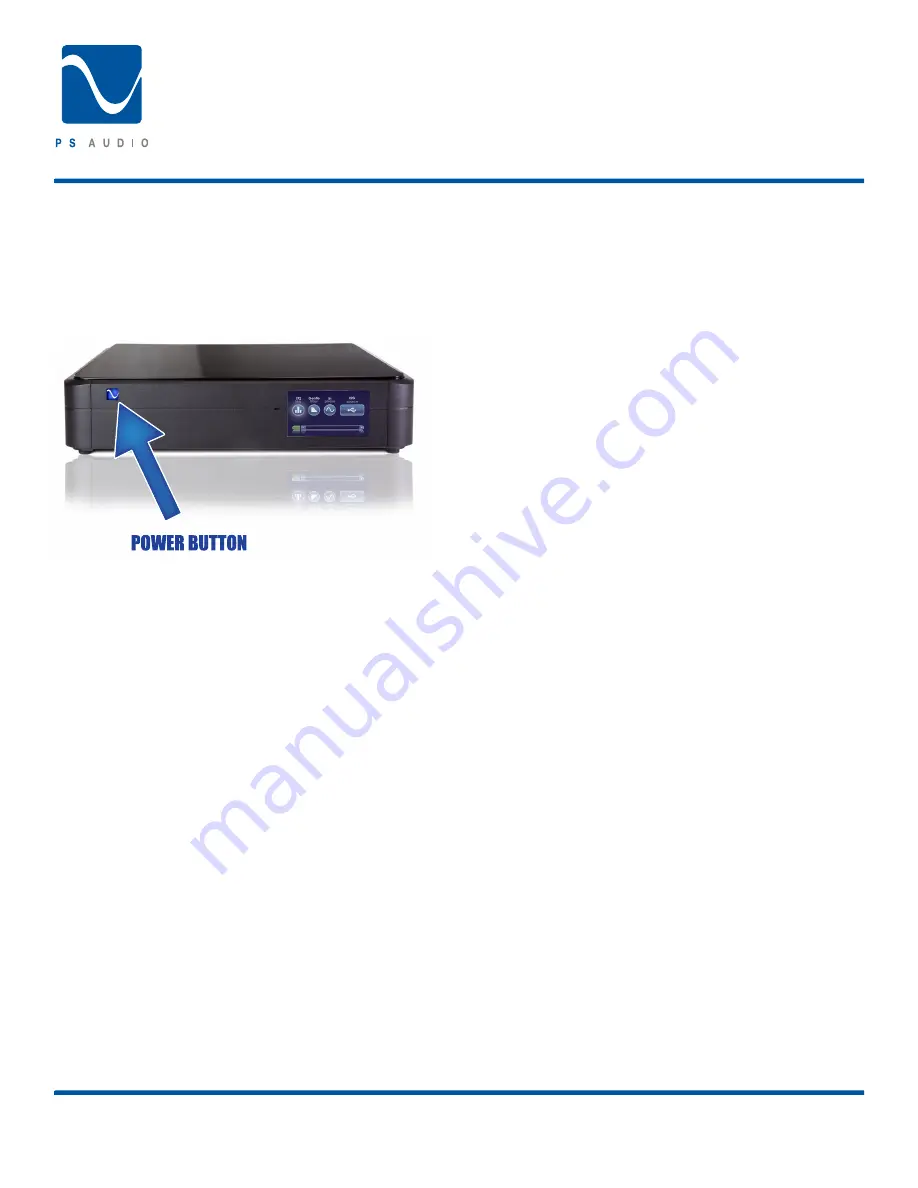
Powering the PWD
Turn the AC power switch in the rear of the PWD to the ON
position. The power switch is located just above the AC inlet.
As soon as the switch is activated the front panel touch screen
will display the initializing screen. This screen shows when the
PWD’s internal “engine” is being loaded with the firmware that
runs the PWD.
After the INITIALIZING SCREEN, you will see the main screen of
the PWD.
ON/OFF button
The front panel PS logo, located on the far left hand corner of
the unit, is the on/off standby control for the PWD. Press this
button to turn the unit on/off. This is a “soft” power button.
When pressed, the display as well as the outputs are turned off.
All the unit’s internal circuitry remains active and ready for play.
Press the PS logo button to activate the unit when you wish to
play music.
Select the Input
The first step is to select the input you wish to play. The input
select is on the far right hand side of the touch screen. Touch
the input selector icon (or use the remote) and the input
selection list appears. Scroll through the list and touch the
input you wish to play. The screen reverts back to the main
screen and the selected input is displayed. Each input, with the
exception of USB and Media Bridge, has a lock light associated
with it. The lock light has two states: connected (green) and not
connected (red). This lock light indicator is located in the upper
right hand corner of the input icon.
Input Naming
For greater convenience it is possible to assign a custom name
to each input such as PerfectWave Transport, Apple TV, etc. To
name each input, touch the input icon from the main screen.
The input list appears. Touch the small edit icon of the input you
wish to name and the edit screen appears. Type in the name of
the product and touch “SUBMIT”. If you wish to return to
the default input name, go to the second keyboard screen
(accessed by pressing the numeric key labeled 123/.!) and touch
“Restore Default”.
Sample Rate
The PWD offers both NATIVE as well as multiple up and down
sample rate options through the Sample Rate Converter (SRC)
icon. Touch the SRC ICON or use the remote keys labeled
SR- and SR+ to change the sample rate. NATIVE is the original
untouched sample rate as transferred from the digital source.
Use this mode whenever you are using an I2S input, a high-
resolution audio file or, as your listening experience would
suggest. Many people feel that NATIVE is a cleaner and more
natural presentation of audio that does not rely on the digital
manipulation found in the SRC. Nearly all DACS use sample rate
converters (SRC’s) for elimination of jitter inherent in the S/PDIF
conversion process as well as to help the audio sound better.
When using the PWT alongside the PWD, there is very little to
no jitter to be concerned with so it is questionable whether you
might want the SRC in the picture at all. Thus we added, on the
touch screen of the PWD, Native mode. Native simply means
that there is no sample rate converter used and we receive
whatever the source is producing natively.
If you are playing a CD, native gives you 44.1kHz (the native
sample rate of a CD). Playing a high-resolution audio disc, you
get that sample rate (96kHz to 192kHz). Native mode is one of
the stronger features of the PWD and experimenting with the
system will show off its qualities. Increasing or decreasing the
sample rate is a matter of personal preference and these setting
should be determined through listening. The NATIVE sample
rate for CD’s is 44.1kHz. Sample rates for computer audio is
either 48kHz or 96kHz depending on your computer setup and
source material. You probably do not want to down-sample
for any reason. Therefore, choose at least the native sample
rate for any input. The PWD will memorize the last setting
chosen for the input you are on. So, for instance, if you choose
NATIVE while on input I2S2 and 192kHz for RCA, the SRC will
automatically switch to that setting when you change inputs.
Filter
The PWD offers a wide assortment of digital filters. Digital filters
are necessary and used in all modern DACS but few are as
sophisticated as those in the PWD. The problems with any filter,
whether it is analog or digital, are the effects they have on the
passband (usable audio frequencies).
Filters leave several types of negative artifacts: group delay,
phase and ripple errors. Some filters minimize phase and group
delay errors while others minimize ripple errors. Each error is
minimized at the expense of the other; thus, there is no such
thing as a perfect filter and, as with many things in electronics,
each is a tradeoff with good and bad points.
Control & Operation
®
4826 Sterling Drive, Boulder, CO 80301
PH: 720.406.8946 | [email protected] | www.psaudio.com
15-042-21-1 Rev A
Instruction i
©2010 PS Audio International Inc. All rights reserved.
Owner’s Reference
Perfect Wave DAC























